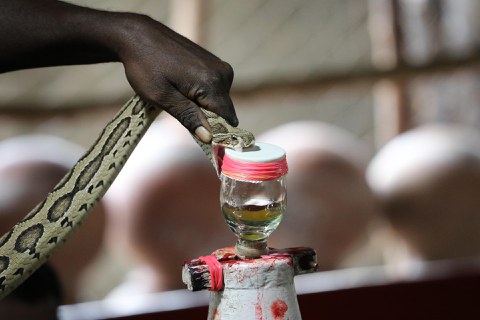Apr 29, 2025
Animals and Money: Milking Snakes, Saving Lives: Production of Antivenom in Australia

First step of the antivenom production.
Australia is home to fauna as varied as they are dangerous: Of the 140 terrestrial species of snakes living in Australia, about 100 are venomous [1]. Every year, around 500 people are hospitalized by snakes in Australia, 61% of the time by brown snakes (𝘗𝘴𝘦𝘶𝘥𝘰𝘯𝘢𝘫𝘢 𝘵𝘦𝘹𝘵𝘪𝘭𝘪𝘴), tiger snakes (𝘕𝘰𝘵𝘦𝘤𝘩𝘪𝘴 𝘴𝘤𝘶𝘵𝘢𝘵𝘶𝘴), or taipan snakes (𝘖𝘹𝘺𝘶𝘳𝘢𝘯𝘶𝘴 spp.) [2]. Mortality from these bites, however, is only about 2.2 cases per year [3,4]. These numbers have been kept low by a number of factors, the most important of which being the introduction of highly specific antivenoms [5, 6].
To obtain a vial of antivenom, small amounts of snake venom are injected into a large mammal, over a period of several weeks or months until enough antibodies are produced by the animal's immune system. This process is called hyper-immunization. The antibodies are then extracted from the animal's blood and purified to create antivenom. The initial stage of this process is complex and often dangerous. To obtain the venom necessary for antivenom development, "the snake's jaws are forced open, the fangs exposed. The fangs are pushed through a plastic/parafilm membrane hooked over the lip of a glass vessel, and venom is squeezed out" [7]. This so-called “milking” of snakes is done manually and presents risks to the health of the worker, which is one reason for the high cost of antivenom.
On average, the commercial cost of each vial of antivenom is €223 for brown snakes, €279 for tiger snakes, and €1,131 for taipan snakes [8]. The sale price of each vial of antivenom is also related to the amount of venom held in the venom glands of an individual at one time as well as the amount of antivenom required to treat the bite. For example, the venom yield of each bite of a wild taipan snake is on average 77 mg, while the average venom yield for brown snakes is 4.41 mg [9, 10]. However, taipan snake bites also require significantly more antivenom to treat. To generate a 50 mL vial of antivenom from wild taipan snakes, about 90 wild individuals would have to be milked. However, cultivated snakes produce 5 to 7 times more venom than their wild counterparts, and so, approximately 15 bred taipan snakes need to be milked [11], reducing the cost per milking of €74.4.
The volume of each vial of antivenom and the number of vials used for the treatment of snakebites vary according to the species: two 10 mL vials are used for brown snakes, up to four 12 mL vials for tiger snakes and up to five 50 mL vials for taipan snakes [12]. Considering the number of vials needed to treat a snake bite, the antivenom needed for a single bite can cost up to €446 for brown snakes, €1,116 for tiger snakes, and a massive €5,655 for taipan snakes. The average base cost of treatment for a snakebite is about €3,700 (AU$6,000) [13]. This cost takes into account hospitalization costs and can even increase to €9,000 due to antivenom costs [13]. Just taking the base cost per snakebite treatment, the average annual cost is €1,850,000, of which €733,728 goes to the purchase of antivenom vials for these three species, about 0.76% of the 2022-23 budget of the hospital system in Australia [14].
One biotech company, CSL Seqirus (Commonwealth Serum Laboratories), is the single source of antivenoms and other necessary products for snake bite treatment in Australia [15, 16]. Although the antivenoms division of this company is particularly small, it has established itself as a critical element within the Australian healthcare system. In fact, last year the Australian government extended a partnership with CSL Seqirus and Papua New Guinea's department of health to share vials of antivenom for snakes and marine creatures with the nation [17]. The production of antivenom is a growing industry that is saving hundreds of lives each year in Australia. Now, as other parts of the world hope to deal with their own venomous snakes, this industry will be spreading far and wide.
Gabriel Pinto
